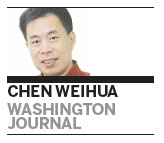Changes in US military sales not a big deal for Beijing
Updated: 2013-10-17 10:57
By Chen Weihua (China Daily USA)
|
||||||||
The US government's loosening up of some arms exports this week has raised a few eyebrows, yet there is no sign that the US has changed its existing policy of an arms embargo on China.
Thousands of parts for military aircraft - such as propeller blades, brake pads and tires - will be able to be sent to almost any country in the world, with minimal oversight, even to some countries subject to UN arms embargos, the news website ProPublica reported this week.
Under the old system, military equipment manufacturers and exporters had to register with the Department of State and get a license for each planned shipment. US officials then scrutinized each proposed deal to ensure that the receiving nation was not violating human rights and to determine the risk of the shipment ending up in the hands of terrorists or other questionable groups.
The new system will move whole categories of equipment encompassing tens of thousands of items from the State Department to the Commerce Department, where oversight is expected to be far more lax.
However, military equipment such as fighter jets, drones and other systems and parts will remain under the tighter scrutiny of the State Department.
The new move is regarded as a victory for defense firms. US administration officials have also argued that the new rules, part of President Barack Obama's Export Control Reform Initiative, will benefit the country's economy. But critics have blasted the new rules as contrary to Obama's call at home for tougher gun controls.
While some of these military parts may now be available to China, those advanced arms systems that China really needs will still be on the ban list.
Bonnie Glaser, senior advisor for Asia at the Center for Strategic and International Studies, said the decision to ease restrictions on the export of military technology applies to some dual-use categories and spare parts, not major weapons systems.
"Under the new regulations, it is possible that China might be able to secure the spare parts for the Blackhawk helicopters that it procured from the US many years ago, but has been barred from obtaining spare parts to maintain," she said, referring the Blackhawks that China bought in the 1980s when the US eased its restrictions on arms exports to China, including mostly non-lethal military equipment, such as anti-aircraft radar, transport helicopters and various electronic devices. However, the US again imposed tighter restrictions on arms sales to China in the late 1980s.
"This does not open the door to the sale of US weapons to China nor is it a precursor to a lifting of the EU arms embargo on China," Glaser said.
Douglas Paal, vice-president for studies at the Carnegie Endowment for International Peace, said the US arms embargo on China is unlikely to be repealed.
"And the EU arms embargo has effectively morphed into a set of agreed standards on arms-related transfers that would continue to preclude most arms-related transfers to China," he said.
The European Union has also imposed an arms embargo on China since 1989. Although several major EU nations have supported a lifting of the embargo in recent years, it is still difficult to reach a consensus in the now 28-member union. Pressure from the US opposing the lifting also weighs heavily on the EU decision.
Former Chinese Premier Wen Jiabao expressed his deep regret last year at the EU's failure to lift the embargo while bilateral relations have expanded tremendously.
China has also repeatedly called on the US to loosen its restrictions on high-tech exports, including military technology, to China. The restrictions have been regarded by China as an obstacle to bilateral relations.

The US is by far the world's largest arms exporter. According to the US Congressional Research Service, US agreements for foreign arms sales totaled around $66.3 billion in 2011, three times higher than the previous year.
The Asia-Pacific has increasingly become the largest market for the US as it pursues its policy of pivot to the region. An earlier Reuters report, quoting Pentagon sources, said US arms sales agreements to its allies in Asia rose to $13.7 billion in fiscal 2012, up 5.4 percent from a year before.
According to Stockholm International Peace Research Institute, the world's top five arms importers from 2007 to 2011 were all from Asia, led by India, Republic of Korea, Pakistan, China and Singapore.
While the US boosts its arms sales in Asia and around the world, it has tried to block Chinese arms imports and exports.
Just this month, the US and NATO both expressed concerns over Turkey's decision to co-produce a missile defense system with a Chinese company. Chinese Foreign Ministry spokeswoman Hua Chunying said relevant parties "should not politicize normal commercial competition".
Contact the writer at chenweihua@chinadailyusa.com
(China Daily USA 10/17/2013 page2)
Most Viewed
Editor's Picks

|

|

|

|

|

|
Today's Top News
US debt impasse ending, Obama to sign bill
Facebook goes fishing in China
Michigan auto czar leading trade trip to China
Yuan gains the most in 20 years
Tibet avalanche claims 4
First interprovince subway route opens
US expert finds job 'rewarding'
Trending news across China
US Weekly

|

|















